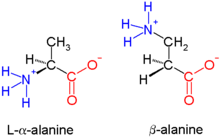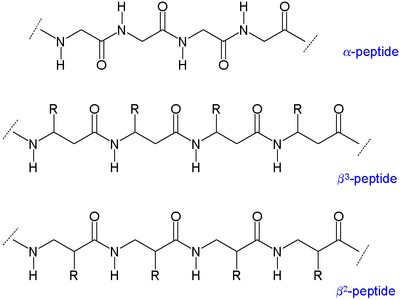Beta-peptide

Beta-peptides (β-peptides) are peptides derived from β-amino acids, in which the
Structure
As there are two carbons available for substitution, β-amino acids have four sites (chirality included; as opposed to two in α-amino acids) for attaching the organic residue group.[3] Accordingly, two main types β-amino acids exist differing by which carbon the residue is attached to: ones with the organic residue (R) next to the amine are called β3 and those with position next to the carbonyl group are called β2. A β-peptide can consist of only one kind of these amino acids (β2-peptides and β3-peptides), or have a combination of the two. Furthermore, a β-amino acid can form a ring using both of its sites and also be incorporated into a peptide.[3]

Synthesis
β-Amino acids have been prepared by many routes,
Secondary structure
Because their backbones are longer than those of normal
Many types of helix structures consisting of β-peptides have been reported. These conformation types are distinguished by the number of atoms in the hydrogen-bonded ring that is formed in solution; 8-helix, 10-helix, 12-helix, 14-helix,[6] and 10/12-helix have been reported. Generally speaking, β-peptides form a more stable helix than α-peptides.[7]
Clinical potential
β-peptides are stable against proteolytic degradation in vitro and in vivo, a potential advantage over natural peptides.[8] β-Peptides have been used to mimic natural peptide-based antibiotics such as magainins, which are highly potent but difficult to use as drugs because they are degraded by proteolytic enzymes.[9]
Examples
β-amino acids with a wide variety of substituents exist. Named by analogy to the biological
